Sessue Hayakawa (1889–1973) was a Japanese actor who starred in more than 80 American, Japanese, French, German, and British films. He was the first Asian actor to find stardom first in Hollywood and later in Europe. His 'broodingly handsome' good looks and typecasting as a sinister villain with sexual dominance made him a heartthrob among female audiences in the 1910s and early 1920s. Nowadays he is best remembered for his Oscar-nominated turn as Japanese POW camp commander Saito in The Bridge on the River Kwai (1957).
![Sessue Hayakawa]()
British Real Photograph postcard in the Picturegoer Series, London, no. 224.
![Sessue Hayakawa]()
French card, no. 638.
Sessue Hayakawa (早川 雪洲) was born Kintaro Hayakawa in the village of Nanaura, now part of the city of Minamibosō in Japan in 1889. His father was the provincial governor and his mother a member of an aristocratic family of the 'samurai' class. The young Hayakawa wanted to become a career officer in the Japanese navy, but he was turned down due to problems with his hearing.
He studied political economics at the University of Chicago to fulfil his family's wish that he become a banker. After his second year of studies at the University of Chicago, Hayakawa decided to quit school and return to Japan. He travelled to Los Angeles and during his stay, he discovered the Japanese Theatre in Little Tokyo and became fascinated with acting and performing plays. It was around this time that he assumed the name Sessue Hayakawa.
One of the productions in which Hayakawa performed was called The Typhoon. Legendary producer-director Thomas Ince saw the production and offered to turn it into a silent movie with the original cast. The Typhoon (Reginald Barker, 1914) became an instant hit and was followed by two additional pictures produced by Ince, The Wrath of the Gods (Reginald Barker, 1914) co-starring his new wife, actress Tsuru Aoki, and The Sacrifice (?, 1914). With Hayakawa's rising stardom, Jesse L. Lasky offered Hayakawa a contract at Famous Players-Lasky (now Paramount Pictures).
Hayakawa's second film for Famous Players-Lasky, The Cheat (Cecil B. DeMille, 1915) with Fannie Ward, was a huge success. Again, he distinguished himself by giving a naturalistic performance. Following The Cheat, Hayakawa became a top leading man for romantic dramas in the 1910s and early 1920s.
His 'broodingly handsome' good looks and typecasting as a sinister villain with sexual dominance made him a heartthrob among American women, and the first male sex symbol of Hollywood, several years before Rudolph Valentino. He became one of the highest paid stars of his time, earning $5,000 per week in 1915, and $2 million per year through his own production company, Haworth Pictures, during the 1920s.
Wikipedia: "During the height of his popularity, critics hailed Hayakawa's Zen-influenced acting style. Hayakawa sought to bring muga, or the 'absence of doing,' to his performances, in direct contrast to the then-popular studied poses and broad gestures. He was one of the first stars to do so, Mary Pickford being another."
Hayakawa and wife Tsuru Aoki lived in a landmark home, built in the style of a French castle. He drove a gold plated Pierce-Arrow and entertained lavishly in his 'Castle' which was known as the scene of some of Hollywood's wildest parties. But in 1923, his waning popularity and a bad business deal forced Hayakawa to leave Hollywood.
![Sessue Hayakawa]()
British postcard in the Pictures Portrait Gallery by Pictures Ltd, London, no. 45.
![Sessue Hayakawa]()
British postcard. Photo: Anderson / Walker.
![Sessue Hayakawa]()
French postcard by Cinémagazine-Edition, no. 16.
![Sessue Hayakawa]()
French postcard in the series Les Vedettes de Cinéma by A.N., Paris, no. 58.
The next 15 years Sessue Hayakawa performed in New York, in Europe and in Japan. In France, he starred in La bataille/The Battle (Sessue Hayakawa, Édouard-Émile Violet, 1923), a popular melodrama spiced with martial arts. He also appeared in the French crime drama J'ai tué!/I Have Killed (Roger Lion, 1924) with Huguette Duflos.
In the UK, he made Sen Yan's Devotion (A.E. Coleby, 1924) and The Great Prince Shan (A.E. Coleby, 1924) with Ivy Duke. In 1925, he wrote a novel, The Bandit Prince, and adapted it into a short play. In 1930, he performed in Samurai, a one-act play written especially for him, for Great Britain's King George V and Queen Mary,
In 1931 Hayakawa returned to Hollywood to make his talking-picture debut playing Fu Manchu in Daughter of the Dragon (Lloyd Corrigan 1931), featuring Anna May Wong. Sound revealed that he had a heavy accent, and his acting got poor reviews.
He returned to Japan where he made a series of films before once again going to France. There he made the geisha melodrama Yoshiwara (Max Ophüls, 1937) with Pierre Richard-Willm. He also appeared in a French remake of The Cheat called Forfaiture (Marcel L'Herbier, 1937), playing the same role that over 20 year earlier had made him one of the biggest stars in the world.
Sessue Hayakawa played a Samurai in the German-Japanese co-production Atarashiki tsuchi/The New Earth (1937), which was co-directed by Arnold Fanck and Mansaku Itami.
Later, he found himself trapped and separated from his family, when the Germans occupied France in 1940. Hayakawa made few films during these years, but supported himself by selling watercolours. He joined the French Resistance and helped Allied flyers during the war.
![Anna May Wong and Sessue Hayakawa in Daughter of the Dragon (1931)]()
German postcard by Ross Verlag, no. 6403/1, 1931-1932. Photo: Paramount. Publicity still for Daughter of the Dragon (Lloyd Corrigan, 1931) with Anna May Wong.
![Sessue Hayakawa]()
French postcard by Edit. Chantal, no. 518. Photo: U.F.S.C.
![Sessue Hayakawa]()
French card, no. 37. Photo: Discina.
![Sessue Hayakawa]()
French postcard. Photo: Studio Carlet ainé, no. 33.
After the war, Sessue Hayakawa's friendships with American actors led him to return to Hollywood. In 1949, Humphrey Bogart's production company located Hayakawa and offered him a role in Tokyo Joe (Stuart Heisler, 1949). Before issuing a work permit, the American Consulate investigated Hayakawa's activities during the war and found that he had in no way contributed to the German war effort.
Hayakawa followed Tokyo Joe with Three Came Home (Jean Negulesco, 1950), in which he played real-life POW camp commander Lieutenant-Colonel Suga, opposite Claudette Colbert. He had re-established himself as a character actor.
His on-screen roles of the 1950s can best be described as the honourable villain, a figure exemplified by his portrayal of Colonel Saito in The Bridge on the River Kwai (David Lean, 1957). The film won the 1957 Academy Award for Best Picture and Hayakawa received a nomination for Best Supporting Actor, losing to Red Buttons. He was also nominated for a Golden Globe for the role that he called the highlight of his career.
After that film, Hayakawa largely retired from acting. Throughout the rest of his life he performed on a handful of television shows and a few films. He played the pirate leader in Disney's Swiss Family Robinson (Ken Annakin, 1960) and his final film appearance was in the Japanese film Junjô nijûsô (1967).
Sessue Hayakawa retired from film in 1966. After his wife's death he returned to Japan where he became a Zen master and a drama coach. He authored his autobiography, Zen Showed Me the Way, and appeared on the NBC interview program Here's Hollywood. Hayakawa died in Tokyo in 1973, from a cerebral thrombosis, complicated by pneumonia.
Scene from The Cheat (1915). Source: Kopernikanische Wende (YouTube).
Trailer The Bridge on the River Kwai (1957). Source: SuperUnknown (YouTube).
Source: Jon C. Hopwood (IMDb), Sandra Brennan (AllMovie), Wikipedia and IMDb.
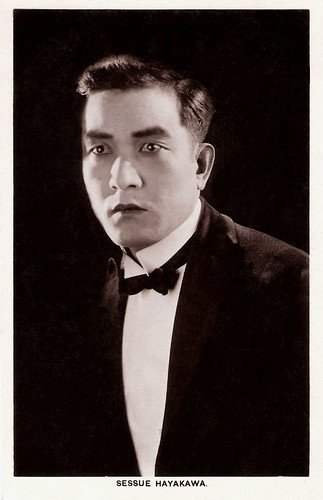
British Real Photograph postcard in the Picturegoer Series, London, no. 224.

French card, no. 638.
The Cheat
Sessue Hayakawa (早川 雪洲) was born Kintaro Hayakawa in the village of Nanaura, now part of the city of Minamibosō in Japan in 1889. His father was the provincial governor and his mother a member of an aristocratic family of the 'samurai' class. The young Hayakawa wanted to become a career officer in the Japanese navy, but he was turned down due to problems with his hearing.
He studied political economics at the University of Chicago to fulfil his family's wish that he become a banker. After his second year of studies at the University of Chicago, Hayakawa decided to quit school and return to Japan. He travelled to Los Angeles and during his stay, he discovered the Japanese Theatre in Little Tokyo and became fascinated with acting and performing plays. It was around this time that he assumed the name Sessue Hayakawa.
One of the productions in which Hayakawa performed was called The Typhoon. Legendary producer-director Thomas Ince saw the production and offered to turn it into a silent movie with the original cast. The Typhoon (Reginald Barker, 1914) became an instant hit and was followed by two additional pictures produced by Ince, The Wrath of the Gods (Reginald Barker, 1914) co-starring his new wife, actress Tsuru Aoki, and The Sacrifice (?, 1914). With Hayakawa's rising stardom, Jesse L. Lasky offered Hayakawa a contract at Famous Players-Lasky (now Paramount Pictures).
Hayakawa's second film for Famous Players-Lasky, The Cheat (Cecil B. DeMille, 1915) with Fannie Ward, was a huge success. Again, he distinguished himself by giving a naturalistic performance. Following The Cheat, Hayakawa became a top leading man for romantic dramas in the 1910s and early 1920s.
His 'broodingly handsome' good looks and typecasting as a sinister villain with sexual dominance made him a heartthrob among American women, and the first male sex symbol of Hollywood, several years before Rudolph Valentino. He became one of the highest paid stars of his time, earning $5,000 per week in 1915, and $2 million per year through his own production company, Haworth Pictures, during the 1920s.
Wikipedia: "During the height of his popularity, critics hailed Hayakawa's Zen-influenced acting style. Hayakawa sought to bring muga, or the 'absence of doing,' to his performances, in direct contrast to the then-popular studied poses and broad gestures. He was one of the first stars to do so, Mary Pickford being another."
Hayakawa and wife Tsuru Aoki lived in a landmark home, built in the style of a French castle. He drove a gold plated Pierce-Arrow and entertained lavishly in his 'Castle' which was known as the scene of some of Hollywood's wildest parties. But in 1923, his waning popularity and a bad business deal forced Hayakawa to leave Hollywood.

British postcard in the Pictures Portrait Gallery by Pictures Ltd, London, no. 45.
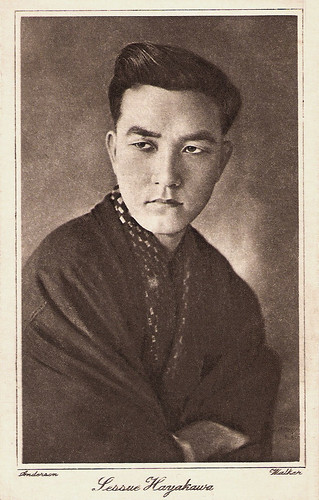
British postcard. Photo: Anderson / Walker.
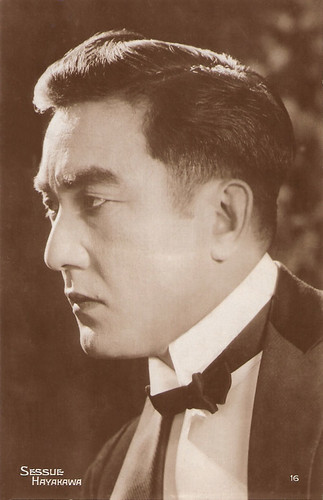
French postcard by Cinémagazine-Edition, no. 16.
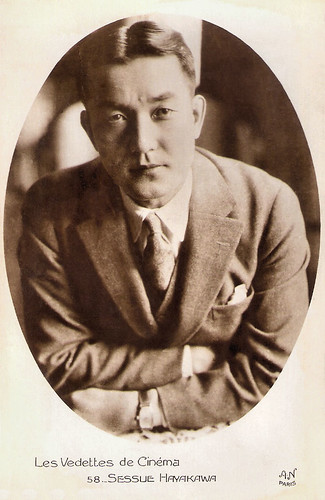
French postcard in the series Les Vedettes de Cinéma by A.N., Paris, no. 58.
Yoshiwara
The next 15 years Sessue Hayakawa performed in New York, in Europe and in Japan. In France, he starred in La bataille/The Battle (Sessue Hayakawa, Édouard-Émile Violet, 1923), a popular melodrama spiced with martial arts. He also appeared in the French crime drama J'ai tué!/I Have Killed (Roger Lion, 1924) with Huguette Duflos.
In the UK, he made Sen Yan's Devotion (A.E. Coleby, 1924) and The Great Prince Shan (A.E. Coleby, 1924) with Ivy Duke. In 1925, he wrote a novel, The Bandit Prince, and adapted it into a short play. In 1930, he performed in Samurai, a one-act play written especially for him, for Great Britain's King George V and Queen Mary,
In 1931 Hayakawa returned to Hollywood to make his talking-picture debut playing Fu Manchu in Daughter of the Dragon (Lloyd Corrigan 1931), featuring Anna May Wong. Sound revealed that he had a heavy accent, and his acting got poor reviews.
He returned to Japan where he made a series of films before once again going to France. There he made the geisha melodrama Yoshiwara (Max Ophüls, 1937) with Pierre Richard-Willm. He also appeared in a French remake of The Cheat called Forfaiture (Marcel L'Herbier, 1937), playing the same role that over 20 year earlier had made him one of the biggest stars in the world.
Sessue Hayakawa played a Samurai in the German-Japanese co-production Atarashiki tsuchi/The New Earth (1937), which was co-directed by Arnold Fanck and Mansaku Itami.
Later, he found himself trapped and separated from his family, when the Germans occupied France in 1940. Hayakawa made few films during these years, but supported himself by selling watercolours. He joined the French Resistance and helped Allied flyers during the war.

German postcard by Ross Verlag, no. 6403/1, 1931-1932. Photo: Paramount. Publicity still for Daughter of the Dragon (Lloyd Corrigan, 1931) with Anna May Wong.

French postcard by Edit. Chantal, no. 518. Photo: U.F.S.C.
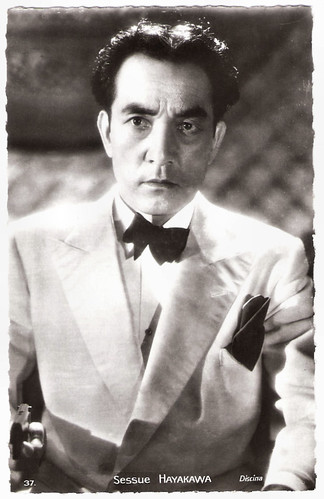
French card, no. 37. Photo: Discina.
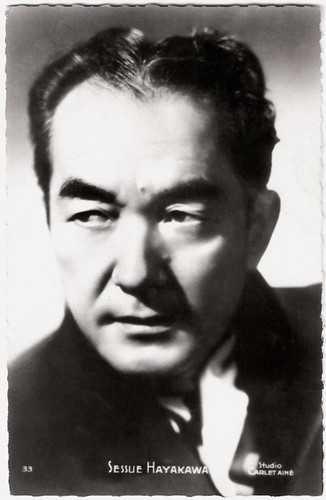
French postcard. Photo: Studio Carlet ainé, no. 33.
The Bridge on the River Kwai
After the war, Sessue Hayakawa's friendships with American actors led him to return to Hollywood. In 1949, Humphrey Bogart's production company located Hayakawa and offered him a role in Tokyo Joe (Stuart Heisler, 1949). Before issuing a work permit, the American Consulate investigated Hayakawa's activities during the war and found that he had in no way contributed to the German war effort.
Hayakawa followed Tokyo Joe with Three Came Home (Jean Negulesco, 1950), in which he played real-life POW camp commander Lieutenant-Colonel Suga, opposite Claudette Colbert. He had re-established himself as a character actor.
His on-screen roles of the 1950s can best be described as the honourable villain, a figure exemplified by his portrayal of Colonel Saito in The Bridge on the River Kwai (David Lean, 1957). The film won the 1957 Academy Award for Best Picture and Hayakawa received a nomination for Best Supporting Actor, losing to Red Buttons. He was also nominated for a Golden Globe for the role that he called the highlight of his career.
After that film, Hayakawa largely retired from acting. Throughout the rest of his life he performed on a handful of television shows and a few films. He played the pirate leader in Disney's Swiss Family Robinson (Ken Annakin, 1960) and his final film appearance was in the Japanese film Junjô nijûsô (1967).
Sessue Hayakawa retired from film in 1966. After his wife's death he returned to Japan where he became a Zen master and a drama coach. He authored his autobiography, Zen Showed Me the Way, and appeared on the NBC interview program Here's Hollywood. Hayakawa died in Tokyo in 1973, from a cerebral thrombosis, complicated by pneumonia.
Scene from The Cheat (1915). Source: Kopernikanische Wende (YouTube).
Trailer The Bridge on the River Kwai (1957). Source: SuperUnknown (YouTube).
Source: Jon C. Hopwood (IMDb), Sandra Brennan (AllMovie), Wikipedia and IMDb.